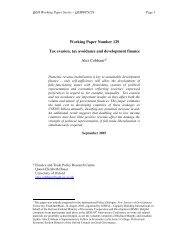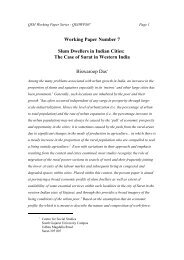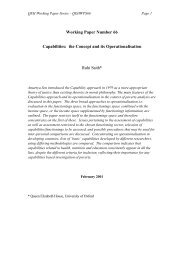Acute Multidimensional Poverty: A New Index for Developing ... - OPHI
Acute Multidimensional Poverty: A New Index for Developing ... - OPHI
Acute Multidimensional Poverty: A New Index for Developing ... - OPHI
You also want an ePaper? Increase the reach of your titles
YUMPU automatically turns print PDFs into web optimized ePapers that Google loves.
<strong>Acute</strong> <strong>Multidimensional</strong> <strong>Poverty</strong>: A <strong>New</strong> <strong>Index</strong> <strong>for</strong> <strong>Developing</strong> CountriesAlkire & Santos0From the matrix g we construct a column vector c of deprivation counts, whose i th d 0entry ci gj1ijrepresents the sum of weighted deprivations suffered by person i 7 . Second, we need to identify whois to be considered multidimensionally poor. To do so, we select a second cutoff k>0 and apply itacross this column vector c. More <strong>for</strong>mally, let : d d R R 0,1, kbe the identification functionddthat maps from person i´s achievement vector yi R and cutoff vector z in R to an indicatorvariable. ktakes the value of 1 when c i k , and k( y i, z) 0 when c i k . That means that aperson is identified as poor if her weighted deprivation count is greater than or equal to k. This iscalled a dual cutoff method, because it uses the within dimension cutoffs z jto determine whether aperson is deprived or not in each dimension, and the cross-dimensional cutoff k to determine who is tobe considered poor.To aggregate in<strong>for</strong>mation about poor persons into the population-wide measure MPI, we focus onpoor people by censoring the deprivations of persons who are deprived but non-poor given k. Todo that we construct a second matrix0 0g ( k ), obtained from g by replacing its i th 0row giwith avector of zeros whenever k= 0. This matrix contains the weighted deprivations of all persons whohave been identified as poor and excludes deprivations of the non-poor. From this censored matrixwe construct the censored vector of deprivation counts ck ( ) which differs from vector c in that it countszero deprivations <strong>for</strong> those not identified as multidimensionally poor. 8 M 0 is simply the mean of thematrix0 0g ( k ), that is M0 ( g ( k)), where μ denotes the arithmetic mean operator. In words, M 0is the weighted sum of the deprivations the poor experience divided by the total number of peopletimes the total number of dimensions considered. 9Interestingly, it can be verified that M 0 can also be expressed as the product of two intuitivemeasures: the (multidimensional) headcount ratio (H) and the average deprivation share among thepoor (A). H is simply the proportion of people that are poor. That is, H q n where q is thenumber of poor people; it represents the incidence of multidimensional poverty. To understand A,we first notice that ci( k)/d indicates the fraction of weighted indicators in which the poor person iis deprived. The average of that fraction among those who are poor (q), is precisely A, where itsnexpression is given by A ci( k)dq. A represents the intensity of multidimensional poverty.i1In this way, the M 0 measure summarises in<strong>for</strong>mation on the incidence of poverty and its intensity,hence its name of Adjusted Headcount Ratio. As a consequence of combining both H and A, M 0satisfies dimensional monotonicity 10 : if a poor individual becomes deprived in an additional dimension,the M 0 will increase. This is a very important advantage over the multidimensional headcount, which7 Note that c i is simply the sum of all the entries in the i th row of matrix8 Note thatg ( k) g ( y , z)and c ( k) c( y , z).0 0ij ij ii i in d0 i1 j1ij9 0In a more conventional notation: M g nd .10 Alkire and Foster (2007) define the axiom <strong>for</strong>mally and explain the intuition thus: “Dimensional monotonicity specifiesthat poverty should fall when the improvement removes the deprivation entirely.” In other words, if a person who wasdeprived in four dimensions is now deprived in three dimensions only, by dimensional monotonicity, poverty shouldfall.0g .www.ophi.org.uk July 2010 10













